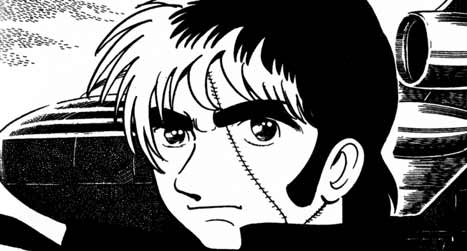Rumiko Takahashi

Biography:
Rumiko Takahashi was born in Niigata, Japan on October 10, 1957.Manga:
For a more complete Bibiliography check out: Rumic WorldAnime:
Works Cited:
Hayao Miyazaki

Biography:
Hayao Miyazaki was born January 5, 1941.Manga:
Anime:
Works Cited:
Katsuhiro Otomo

Biography:
Katsuhiro Otomo was born April 14, 1954. Otomo is most famous for his work on both the animated feature film and 2000 page manga series Akira. Akira started in a bi-monthly magazine called "YOUNG MAGAZINE" and was published from 1982 to 1990. While the Western world credits Otomo mostly with Akira, his first hit in Japan was called Domu: A Child's Dream. Domu was very similar to Akira in that both revolved around "children" with telekinetic powers. In Akira we have the Espers, a group of three "children" with telekinetic powers and while they look like children they are much older because of testing done on them to keep their powers under wraps. Appearance wise they have pale white hair and blue wrinkled skin. Inversely, in Domu there is a senile old man named Chojiro Uchida. He too has psychic powers but unlike the Numbers from Akira, Uchida has the mental capacity of a small child and cannot distinguish right from wrong. He murders without regard thinking that it is all a child's game and that he is not doing anything wrong. Otomo is also well known for his unique art style. Where most anime artists tend to make their characters somewhat unrealistic looking, Otomo's style is more simplistic and realistic to the human form.
 On the left is Otomo's character Tetsuo from Akira and on the right is Osamu Tezuka's Black Jack. As we can see Otomo's style is significantly more realistic when it comes to the nose, eyes, ears, and even shading of the human face. Tetsuo's eyes aren't just the large black dots, but rather you can make out his pupils and his iris.This particular picture is also Tetsuo's eyes at their largest and most open, even then they are smaller than Black Jack's typical gigantic anime eyes. Also, Tetsuo's eyebrows aren't just two colored in black bars, you can see the small hairs that make up his eyebrows. Another feature is the nose, it is not the hooked slant that most anime characters have. It is a defined nose with nostrils. Also, while Otomo doesn't do it for every panel, you can see that Tetsuo has teeth, it isn't just two white bars inside his mouth. There are individual teeth inside his mouth.
On the left is Otomo's character Tetsuo from Akira and on the right is Osamu Tezuka's Black Jack. As we can see Otomo's style is significantly more realistic when it comes to the nose, eyes, ears, and even shading of the human face. Tetsuo's eyes aren't just the large black dots, but rather you can make out his pupils and his iris.This particular picture is also Tetsuo's eyes at their largest and most open, even then they are smaller than Black Jack's typical gigantic anime eyes. Also, Tetsuo's eyebrows aren't just two colored in black bars, you can see the small hairs that make up his eyebrows. Another feature is the nose, it is not the hooked slant that most anime characters have. It is a defined nose with nostrils. Also, while Otomo doesn't do it for every panel, you can see that Tetsuo has teeth, it isn't just two white bars inside his mouth. There are individual teeth inside his mouth.
Manga:
A Gun Report (1973), Short Peace (1979), Highway Star (1979), Fireball (1979), Domu: A Child's Dream (1980), Kibun wa mō Sensō (1980), Sayonara Nippon (1981), Akira (1982), Visitors (1984), Kanojo no Omoide... (1990), The Legend of Mother Sarah (Writer, 1990), ZeD (Writer, 1990), SOS! Tokyo Metro Explorers (1996), Batman: Black & White #4: The Third Mask (1996), Hipira: The Little Vampire (Writer, 2001), Park (2006), Kaba (Artbook, 1987), Akira Portfolio (Artbook, 2002), Akira Club (Artbook, 2007)Anime:
Neo Tokyo (1987), Robot Carnival (1987), Akira (1988), Memories (1995), Steamboy (2004)Works Cited:
Riyoko Ikeda

Biography:
Riyoko Ikeda was born December 18, 1947. Is best known for the manga The Rose of Versailles (Versailles no Bara) which has been claimed as one of the most influential girl's manga. She is also a member of the Year 24 Group, a group of female manga artists that revolutionized Shojo Manga. Riyoko's inspiration to draw manga came reading the manga of Osamu Tezuka. Much of her earlier work also heavily resembled the art style of Osamu Tezuka. Her first manga, "Bara Yashiki no Shojo", is a direct reference to Osamu Tezuka's "Bara Yashiki no Nazo".Manga:
Bara Yashiki no Shōjo, Soyo Kaze no Mary, The Rose of Versailles, Shōko no Etude, Claudine, Oniisama e, Orpheus no Mado, Jotei Ecatherina, Eikou no Napoleon – Eroica, Der Ring des Nibelungen, Spring Snow, Ten no Hate Made - Poland Hishi, Ayako, Epitaram: A Wedding SongAnime:
Works Cited:
Ideas, requests, problems regarding CSUSB Community Wiki? Send feedback

